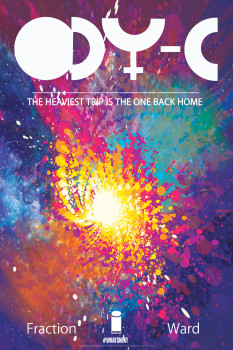Ody-C Issue #2: In Which I Try to Not Use the Word “Weird” at All
Author’s Note: I had wondered how I would handle spoilers as I review my way through the first handful of issues of Ody-C, the new genderqueer retelling of Homer’s Odyssey. At first I thought this wouldn’t be necessary: how many spoilers will there be in the retelling of a three thousand year old myth? As of now, with the second issue released, I can safely say “At least a few”. So while I will avoid any plot-altering spoilers to the fullest extent possible, if you don’t want to be spoiled on world building or character development, read no further.
At the conclusion of the first issue of Ody-C, I wasn’t certain of how I felt about the series. I had opinions, certainly, and I had impressions and ideas, but it was hard to compile those into a solid opinion. After reading the second issue, which was released last week, I feel far more comfortable saying that I think I am going to love this.
As a single issue goes, Ody-C #2 is slender in terms of both page length and events. But it is incredibly dense in terms of world-building. While the bones of this story were familiar in issue 1, the setting and surroundings were so strange as to leave this reader at least feeling a bit adrift. Issue 2 leads us deeper into the world, and while it is in some ways more surreal it is also leaves us far more grounded in what the world Matt Fraction and Christian Ward are creating looks like.
The issue opens on Zeus. The All-mother pontificates upon the difficulties of parenthood and the tendency of children to surpass their parents. As in Classical Myth, Zeus is terrified of the idea that one day, she will be slain by one of her children just as she took the throne from her father, Cronus.
Unlike in Greek myth, she ensure this would happen by destroying men. All of them, everywhere, in a single instant. This radical step would have solved all of her problems permanently, were it not for her daughter Promethene. This version of the titan brought womankind not fire but life itself, created in a lab: the Sebex, a new life-form that was neither male nor female, capable of implanting a donated ovum in its own womb and fertilizing it. Since the will of Zeus was contramanded in spirit if not in word, Promethene was sentenced to being bound in the darkness of space and kept in a perpetual sleep, fueled by the lotus blossom.
Which, of course, ties us neatly to the next episode in Odyssia’s journey home. In Homer the Island of the Lotus Eaters was a refueling point at which Odysseus’ sailors became so enamored with the drugging lotus that they nearly forgot to return home until they were bodily carried back on the ship. In Matt Fraction’s universe, it is a world that has grown out of Promethena’s chained body that also serves as a pleasure palace, successive levels of vice on offer to those traveling homeward from war. Here Odyssia begins to confront her own feelings on the war and on the idea of returning home before continuing on her journey, and Zeus and Poseidon begin to plot against that return.
Christian Ward’s art is even more surreal here than in the first issue: appropriate, given the topics involved. The images are impressionistic memories, less album-cover psychedelic and more watercolor. But as the story grows more clear and the style of Ody-C becomes familiar the images also become more coherent. Fraction’s writing is less fractured as well, and while he still loves his epithets (as do I: Odyssia is “Wolf-witch, ShiftWitch, Hex-Jack”) he seems to be slowly easing towards a more comfortable narrative style. There is still clearly a lot of narrative ground to cover, but as the beast takes shape I am intrigued and excited by what I see.
A retelling of this size and scope is an ambitious undertaking. Two issues in, it appears to be one that Fraction and Ward are well capable of managing well.
Is anyone else reading this yet? And if so, what do you think? Do you like their transformation of the myth, or is it just too much?
Read Elizabeth Cady’s review of the 3rd and 4th issues of ODY-C here.

[…] Issue 2 of Ody-C is reviewed here. […]